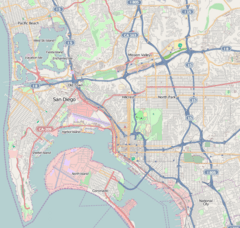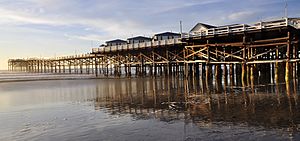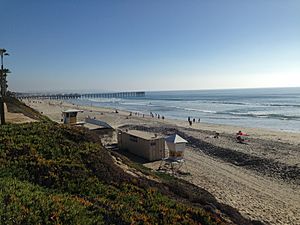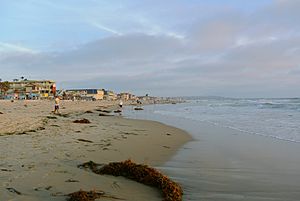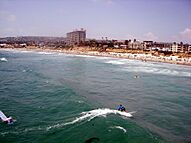Pacific Beach, San Diego facts for kids
Quick facts for kids
Pacific Beach, San Diego
|
|
|---|---|
| Pacific Beach | |
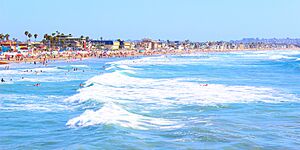
The beach at Pacific Beach looking south
|
|
| Nickname(s):
"P.B."
|
|
| Country | |
| State | |
| County | |
| City | |
Pacific Beach is a lively neighborhood in San Diego, California. It is often called "P.B." by local residents. This area is known for its beautiful beaches and fun atmosphere.
Pacific Beach is located between La Jolla to the north and Mission Beach and Mission Bay to the south. To the east, you'll find Interstate 5 and Clairemont, and to the west is the Pacific Ocean. It's a popular spot with many places to eat and shops, especially along Garnet Avenue and Mission Boulevard.
Contents
History of Pacific Beach
Before Europeans arrived, the Kumeyaay people lived in this area. They had a large village called Hamo or Jamo near Rose Creek.
Early Development and Growth
San Diego grew a lot after a cross-country railroad was finished in 1885. Pacific Beach itself started developing between 1886 and 1888. Key people like D. C. Reed and O. S. Hubbell helped create the town. Hubbell was known for mapping out lots and starting sales.
A railway line connected Pacific Beach to downtown San Diego in 1889. This line was later extended to La Jolla in 1894, making travel easier.
Some early attractions in Pacific Beach included a race track and the San Diego College of Letters. These no longer exist today. Around 1900, growing and packing lemons became a big part of the local economy.
Landmarks and Schools
In 1910, the Army and Navy Academy, a special school, opened in an old college building. A public high school followed in 1922, and a junior high school in 1930.
One famous landmark, Crystal Pier, opened in 1927. The Roxy Movie theater opened in 1943. Many hotels were built after World War II, like the Bahia (1953) and the Catamaran (1959). In 1972, a rule was made to limit building heights to 30 feet. This rule is still in place today.
Community Changes and Renaming
In 1945, some residents wanted to remove the name of William Payne from the middle school. This was because he was a Black teacher. In 2021, the San Diego Unified School District decided to rename a field at the middle school after William Payne and his wife Fannie. This honored their contributions and promoted fairness.
During World War II, the United States Navy used Pacific Beach for anti-aircraft training. In the 1960s, the city invested in Mission Bay Park. This led to more development, including new hotels and the opening of SeaWorld San Diego in 1964.
Geography of Pacific Beach
The Beach and Boardwalk
The beach in Pacific Beach is very long, stretching from the Mission Bay jetty all the way to the cliffs of La Jolla.
The boardwalk is a popular path for walking, biking, and skating. It's officially called Ocean Front Walk/Ocean Boulevard. It runs for about 3.2 miles along the beach. You can find many local shops, restaurants, and hotels along the boardwalk. Crystal Pier, a public pier and hotel, is also located here.
Street Names
The streets in Pacific Beach have been renamed several times. Their current names were set in 1900. The main north-south street along the beach is Mission Blvd. Other north-south streets are named after federal officials from the late 1800s. They go in alphabetical order as you move away from the coast: Bayard, Cass, Dawes, Everts, Fanuel, Gresham, Haines, Ingraham, Jewell, Kendall, Lamont, Morrell, Noyes, Olney, Pendleton, Quincy, and Randall.
Most of the east-west streets are named after precious stones. Starting from the north, some of these streets include:
- Agate
- Turquoise
- Sapphire
- Tourmaline - home to Tourmaline Surfing Park
- Opal
- Beryl
- Law
- Chalcedony - pronounced locally "chal-SED-nee" or "CHAL-sə-doh-nee"
- Diamond
- Emerald
- Felspar - an older spelling of "Feldspar"
- Garnet - pronounced locally with the second part stressed, "gar-NET"
- Hornblend - spelled differently from the mineral hornblende
- Grand
- Thomas
- Reed
- Oliver
- Pacific Beach Drive
Climate and Weather
Pacific Beach has a semi-arid subtropical climate. This means it has warm summers and mild winters. The sun shines for more than 300 days each year. The area gets less than 11 inches of rain per year on average.
| Climate data for Pacific Beach, San Diego | |||||||||||||
|---|---|---|---|---|---|---|---|---|---|---|---|---|---|
| Month | Jan | Feb | Mar | Apr | May | Jun | Jul | Aug | Sep | Oct | Nov | Dec | Year |
| Record high °F (°C) | 89 (32) |
91 (33) |
95 (35) |
99 (37) |
101 (38) |
103 (39) |
108 (42) |
104 (40) |
108 (42) |
107 (42) |
97 (36) |
87 (31) |
108 (42) |
| Mean daily maximum °F (°C) | 65.6 (18.7) |
65.7 (18.7) |
65.8 (18.8) |
68.3 (20.2) |
69.0 (20.6) |
71.0 (21.7) |
74.5 (23.6) |
76.0 (24.4) |
75.5 (24.2) |
72.6 (22.6) |
69.1 (20.6) |
65.2 (18.4) |
69.9 (21.1) |
| Mean daily minimum °F (°C) | 48.9 (9.4) |
50.6 (10.3) |
53.1 (11.7) |
55.8 (13.2) |
59.5 (15.3) |
61.9 (16.6) |
65.4 (18.6) |
66.7 (19.3) |
64.7 (18.2) |
60.5 (15.8) |
53.6 (12.0) |
48.5 (9.2) |
57.4 (14.1) |
| Record low °F (°C) | 30 (−1) |
32 (0) |
39 (4) |
40 (4) |
47 (8) |
51 (11) |
57 (14) |
57 (14) |
54 (12) |
42 (6) |
36 (2) |
34 (1) |
30 (−1) |
| Average precipitation inches (mm) | 2.24 (57) |
2.08 (53) |
2.12 (54) |
0.73 (19) |
0.21 (5.3) |
0.09 (2.3) |
0.03 (0.76) |
0.10 (2.5) |
0.22 (5.6) |
0.39 (9.9) |
1.04 (26) |
1.27 (32) |
10.51 (267) |
Parks and Recreation
Pacific Beach is next to the Pacific Ocean and Mission Bay Park. It also has other great outdoor spaces.
Local Parks
- Kate Sessions Park offers a playground, a large grassy area with ocean views, and trails for hiking and mountain biking.
- Fanuel Street Park is a popular park right on the bay. It has playground equipment for younger and older kids.
- Rose Creek flows through Pacific Beach and into Mission Bay. It's an important natural area with wetlands.
Surfing at Pacific Beach
Pacific Beach is a great place for surfing. The waves are usually good for intermediate surfers. You can surf here all year round. The best conditions are often in the fall and winter when the south wind blows. Many surfers wear wetsuits because the water can be cool, especially in winter.
Community Organizations
Many groups work to make Pacific Beach a better place.
- The Pacific Beach Town Council is a non-profit group that promotes the area and organizes community events.
- Save Pacific Beach is a group of residents who work together to improve the community.
- The Pacific Beach Planning Group gives advice to the city on how land should be used.
- The Pacific Beach and Mission Bay Visitor Center provides information about the area's history, events, and places to stay or eat.
- Other community groups include Kiwanis, Rotary, Lions Club, Girl Scouts, and the Pacific Beach Woman's Club.
Education
Public schools in Pacific Beach are part of the San Diego Unified School District. These schools include:
- Mission Bay Senior High School
- Pacific Beach Middle School
- Pacific Beach Elementary
- Kate Sessions Elementary
- Barnard Elementary
- Crown Point Junior Music Academy
Media
Pacific Beach has local news coverage from the daily San Diego Union Tribune newspaper. There is also a weekly newspaper called the Beach & Bay Press.
In Popular Culture
Pacific Beach has appeared in books and movies.
- In John Dos Passos's book The 42nd Parallel (1930), a character briefly lives in Pacific Beach.
- The movie Love All You Have Left was filmed at a private home in Pacific Beach.
- It was also featured in the seventh part of JoJo's Bizarre Adventure, called Steel Ball Run. It was the starting point for a race from San Diego to New York.
Notable People
Many interesting people have lived in Pacific Beach, including:
- Caroline Amiguet, an actress
- Vinny Curran, an actor
- Dinesh D’Souza, a political commentator
- Mark Dice, a YouTuber
- Roger Guy English, a businessman and world record holder
- Donna Frye, a former city council representative
- Skip Frye, a professional surfer
- Vic Fuentes, a musician
- Adam Gnade, a musician and novelist
- Tony Gwynn Jr., a former MLB baseball player
- Robert Hays, an actor known for his role in Airplane
- Mark Whitney Mehran, owner of Hotrodsurf
- Kate Sessions, a famous Landscape Architect
- Pauly Shore, an actor and former MTV host
- Eddie Vedder, a musician
Gallery
See also
 In Spanish: Pacific Beach para niños
In Spanish: Pacific Beach para niños


